2013 Ford Fusion Hybrid. Click image to enlarge |
| First Drive: 2013 Ford Fusion Test Drive: 2012 Toyota Camry Hybrid Comparison Test: Best Fuel Efficient Cars Manufacturer’s website |
Review and photos by Jonathan Yarkony
Photo Gallery:
2013 Ford Fusion Hybrid
Santa Monica, CA – While the amount of advertising hype that you will see about the Hybrid model might lead you to believe that the 2013 Ford Fusion Hybrid represents a significant portion of Fusion sales, you’d be wrong. The Ford Fusion Hybrid will be a niche player, and only a small part of Fusion sales will be of the hybrid model, about 5 percent if it follows current model splits. And even within Ford’s electrification strategy, the Fusion Hybrid will play second fiddle to the new C-Max, both of which share the same drivetrain. However, that vehicle will be a standalone ‘halo’ hybrid model without a conventionally powered model to overshadow it.
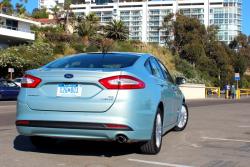 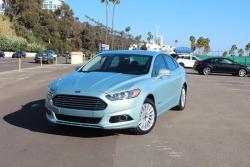 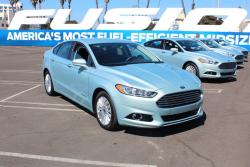 2013 Ford Fusion Hybrid. Click image to enlarge |
And that is exactly where the Fusion Hybrid will remain. In the shadows. In the shadow of the Fusion 1.6L and 2.0L Ecoboost models. In the shadow of the C-Max Hybrid. And in the shadow of the current hybrid sedan leader, the Toyota Camry Hybrid, which we had an opportunity to drive back to back with the Fusion Hybrid.
On paper, the Fusion Hybrid actually stacks up quite nicely against the Camry Hybrid. Ford’s Hybrid delivers 188 net hp to the Camry’s 200 hp (and down even from the previous generation Fusion Hybrid’s 191). It carries 1,640 kg (3,615 lb.), saving 36 kg over the 2012 model, but still much heavier than the Camry’s 1,561 kg (3,441 lb.) despite its lightweight Li-ion battery to the Camry’s NiMH. That power deficit and weight gain can be felt on the road, as the Fusion Hybrid struggles to get up to speed, but it is worth it in the measurement that matters most to someone shopping a hybrid. Transport Canada estimates put the Fusion Hybrid at 4.0/4.1 L/100 km city/highway, compared to the Camry Hybrid’s 4.5/4.9.
Either way you’re commuting efficiently, but for my money, I’ll take the Camry’s extra power. However, in the hybrid market efficiency is king, and the Fusion Hybrid also beats the Prius V wagon’s 4.3/4.8. It takes the smaller Prius’ 3.7/4.0 to top the Fusion’s estimates, although we’ll see how that turns out in real-world driving, where in our experience the Toyotas have proven to stay pretty close to our strict Canadian estimates while Fords struggle to achieve even the easier US EPA estimates (5.0/5.0 L/100 km in the case of the Fusion Hybrid).
Anyhow, the Ford Fusion Hybrid is powered by the same powertrain as the C-Max Hybrid, helping Ford achieve cost savings through economies of scale. These savings were enough to allow Ford to make the leap to lightweight lithium-ion batteries for their hybrids (as well as their ‘Energi’ plug-in hybrids and full electric cars). In the Fusion Hybrid, it is a 1.4 kWh Li-ion battery powering the 118-hp, 117 lb-ft electric traction motor. The internal combustion contribution comes from a 2.0L Atkinson cycle four-cylinder that produces its own 141 hp and 129 lb-ft of torque. The combined 188 hp is routed through a CVT to the front wheels and provides modest acceleration.
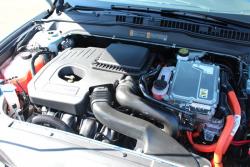 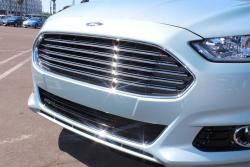 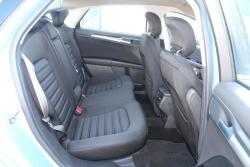 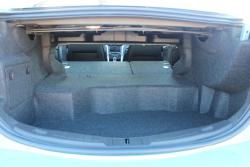 2013 Ford Fusion Hybrid. Click image to enlarge |
Under mild throttle, the car will begin moving exclusively under electric power, and thanks to the more powerful batteries can get the car up to 100 km/h without the intervention of the gas engine. On the streets of Santa Monica, the Fusion Hybrid was more than able to keep up with traffic on battery power alone before tripping the internal combustion engine. You will notice when the gas engine cuts in, with a slight grumble, but very little vibration. Other noises like wind and road noise have been countered by an active noise control system that uses the audio system to effectively cancel out most road noise.
You might also notice a bit of a lurch as the gas engine sets its power to the wheels, though not as much as the grabby brakes when trying to moderately slow down for a light. While the engine’s power delivery and brakes are not as mild and seamless as the Camry Hybrid, they are smoother than the Sonata Hybrid, and it won’t likely be enough to shift a sale one way or the other.
However, looks might be. I am one of the few that thinks the Camry looks handsome, and few will argue that its looks will turn customers away, so safe is its design. The Sonata, well, I can appreciate that some might find it good looking with its crafty fluidic styling, but it’s not exactly my taste. The Fusion, though, I find to be one of the best designs on the market, and only the Kia Optima is in the same league in this segment. Is it good-looking enough to overcome sticky brakes and slightly gruff engine? It would be for me, but some people might be more sensitive to the driving experience and would demand the smoothest possible ride in their hybrid sedan.
Beyond the power delivery and braking, the Hybrid tones down some of the Fusion’s athletic tendencies yet still has a firm suspension, but the 100-plus kg of extra weight (and particularly the unsprung weight of the regen brakes) over the non-hybrid Fusion is felt in a rougher, choppier ride.
Some critics have panned the Fusion’s close quarters, but I can vouch for the back seat—I rode in it for a good half hour, behind a six-foot-plus gentleman, and had plenty of legroom, although headroom was tight. I would estimate that there is plenty of room for two adults in the back, but having someone in the middle seat would cramp everyone despite good shoulder room measurements (1,445 mm, slightly better than the Camry). One feature to note is that the Fusion Hybrid’s rear seatbacks fold down to allow larger objects to fit through—and it isn’t just a small pass-through, it is the full width of the car, if a limited height.
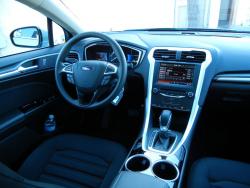 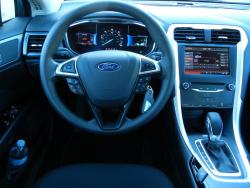 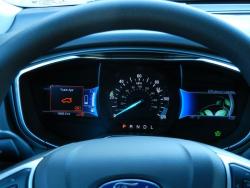 2013 Ford Fusion Hybrid. Click image to enlarge |
The front seats in the model I drove were a simple, black fabric, but their contouring and support were fine for my average body type. The centre console is wide, and aside from the high-quality soft-touch dash, the plastics are average and the design seems to aim for an inoffensive middle ground, unlike the more adventurous Escape and Focus interiors. I had little trouble navigating the MyFord Touch system through its touchscreen, and the primary controls for temperature and audio below the screen make quick work of common adjustments. While some reviewers have bemoaned the lack of indicators or feedback for certain controls, I imagine an owner would get used to this after a couple drives. The slow response of the MFT touchscreen would get old quickly, though, as would its frustrating submenus and deeper navigation functions.
The gauges, however, are clear and bright even in bright sunlight, and the full-color, liquid crystal display (LCD) screens flanking each side of the large central speedo can be changed to show different info like fuel and battery power levels, average and instant fuel consumption, as well driving coaches like Ford’s signature leaves that sprout on a vine as you drive more efficiently. The steering wheel itself is a good shape, but the number of buttons is starting to creep into confusion territory although time might breed a practiced familiarity that we can’t cram in during our test-drive loops on these events.
However, it is plenty of time to cram us full of information on technology, like adaptive cruise control, active park assist, and blind-spot warning system with lane-keeping system. You can read about these and other driver-assistance technologies Ford is working on in our Auto Tech story.
While Ford has brought the price down for the Fusion Hybrid, starting it at $29,999 MSRP with a $1,550 destination charge, and climbing steeply from there when adding tech and other options.
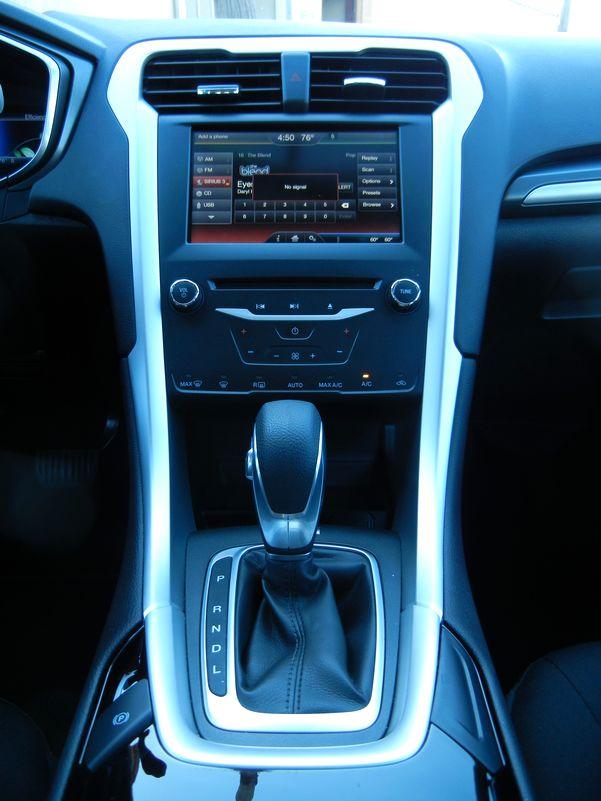 2013 Ford Fusion Hybrid. Click image to enlarge |
This is another area in which Toyota trumps the Ford, pricing their base Camry Hybrid LE at $26,990, with the upgraded XLE model at $28,990 (Camry destination fees are $1,565) with a lengthy list of technology and convenience features. It will take some serious discounts to the Fusion Hybrid for Ford to match this well-priced sedan.
The 2013 Ford Fusion Hybrid is a good car, but its biggest challenge will be luring customers away from other more recognized hybrids, especially in light of the well-oiled Toyota hybrid marketing machine. Toyota has spent generations (three of them for the Prius, two for Camry) aligning themselves with hybrid technology, and they execute it to perfection, especially in the Camry Hybrid, which delivers silky smooth efficient motoring with plenty of power for mid-size sedan owners possibly giving up V6s. The Fusion’s image as a sporty sedan might even work against the Hybrid model, attracting customers to Ford showrooms that will skew towards more potent powertrains.
However, drivers opting for hybrids want efficiency above all else, so time will tell if buyers are willing to spend up for this Fusion Hybrid that promises best-in-class efficiency in a stylish sedan package.
Pricing: 2013 Ford Fusion Hybrid
Hybrid SE FWD: $29,999
Destination: $1,595














